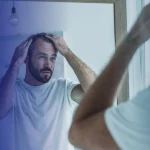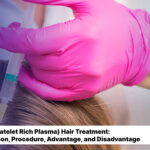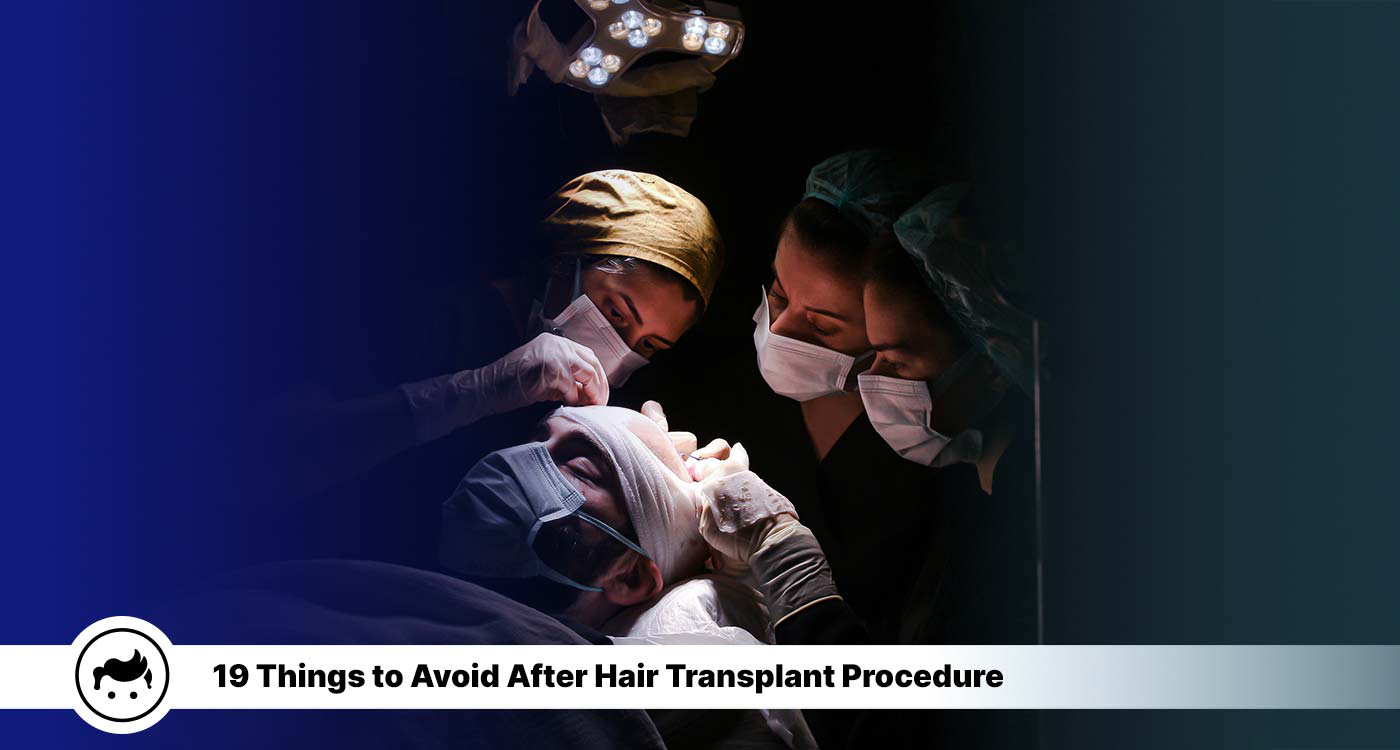
Table Of Content
Listed below are the three main things to avoid after a hair transplant procedure.
Driving means driving a car, truck, or motorbike on a road or highway. It entails controlling the vehicle and adhering to the road rules while also keeping an eye out for other cars and any road hazards. Driving after a hair transplant must be avoided. There are several reasons why an individual must not drive after getting a hair transplant. It reduces the risk of bleeding. Small incisions are made in the scalp using a surgical device called a “punch” during hair transplant treatments. It is not advisable to drive after having incisions since it is painful, and the bleeding possibly worsens. Additionally, it reduces the risk of infection. The scalp is delicate and prone to infection immediately after a hair transplant. An increased risk of infection is associated with driving since the driver’s scalp is more conceivable to come into contact with dust and other airborne pollutants. Moreover, avoiding driving for a while after getting a hair transplant helps lessen the chance of edema. It also reduces the risk of dislodging. The transplanted hair is delicate and readily displaced by the vibrations of a passing vehicle. Moreover, the scalp is uncomfortable, and driving a car is conceivably painful after a hair transplant, particularly if the automobile has a rough seat. Therefore, staying off the road is beneficial for post-transplant pain management. Lastly, the newly transplanted hair possibly be damaged by ultraviolet light, especially when a car is without glass on the roof; therefore, it is essential to avoid driving a car after a hair transplant to protect the head from the sun while driving. On the other hand, there are numerous alternatives to driving after a hair transplant, including public transportation, taxis or ride-sharing services, walking or biking, asking a friend or relatives for a ride, and waiting until fully recovered. Using buses, trains, and subways is an alternative to driving. It enables the patient to avoid physical activity and relax. Additionally, it is a viable choice to ride a taxi or ride-share if one needs to go a short distance but wants to avoid being exposed to dust, UV rays, or the stress of driving. Walking or riding a bike, if the patient is able, is an excellent alternative if they live near the location. It is a healthy method to go outside and move about without causing undue strain on their hair. Moreover, it is a terrific alternative if an individual has someone they trust and is willing to give them a ride. However, waiting until the scalp has wholly healed is recommended before engaging in strenuous activities, such as driving.
Ignoring prescription and over-the-counter medicine labels after a hair transplant refer to failing to read or comply with the directions and precautions stated on the label of a medication used after Turkey hair transplant. It includes failing to follow the appropriate dose, failing to obey the rules for how to take the prescription, and failing to heed any warnings or precautions. Ignoring prescription labels after a hair transplant is risky since it increases the chance of adverse effects, drug interactions, and other issues. It also raises the risk of overdosing, which is fatal. Furthermore, the therapy is able to fail, and the scalp condition possibly continues or worsens if a patient disregards the label’s directions and cautions. Antibiotics must be administered as recommended to prevent infection. Do not drive if the caution label instructs one not to operate heavy equipment or machinery after taking prescription analgesics. Avoid taking too much medicine. Finally, take the prescription with food if directed. Opioids induce gastrointestinal irritation on an empty stomach. On the other hand, there are numerous alternatives to disregarding prescription and OTC medication labels after a hair transplant. Reading and following the instructions on the label is the most critical step in ensuring that any drug is used safely and effectively. Always read the label and follow the dose, administration, and duration of use directions, as well as any warnings or precautions. Additionally, inquire with the doctor or pharmacist for clarification. See a healthcare professional or pharmacist for any questions or concerns regarding a medicine. They provide essential advice on how to take the drug safely and successfully. Keeping a journal of all prescriptions helps to track the medications and their consumption. It is also vital to tell the healthcare provider of any medications currently taken, including over-the-counter medications, to prevent any possible interactions. Moreover, follow the surgeon’s recommendations about the drugs they have given since they are customized to the patient’s unique requirements and possibly affect the healing process. Be mindful of any adverse effects when taking a drug, and notify the healthcare practitioner or pharmacist if there are any unexpected or severe side effects. Furthermore, keep it in a cold, dry location, out of reach of children, and away from light to guarantee the medication’s efficacy and safety.
Flat sleeping is sleeping on one’s back in a flat or horizontal posture, which is the most popular sleeping position; however, it is best to avoid it for at least a week subsequent to a hair transplant. Sleeping flat possibly puts a strain on freshly transplanted hair follicles and damages them or prevents them from fully settling into their new place. Avoiding flat sleeping after a hair transplant helps to protect newly transplanted hair follicles and encourage recovery. It guarantees that the transplanted hair grows in effectively and looks natural. One advantage of not sleeping flat following a hair transplant is that it relieves strain on the transplanted region. The freshly implanted hair follicles are protected from injury by sleeping in a semi-upright posture, which is able to assist in avoiding pressure on the transplanted area. Avoiding flat sleeping ensures that the transplanted hair is left alone to settle into its new spot. Moreover, it minimizes swelling and reduces the risk of infection. Sleeping in a semi-upright posture assists in lowering the risk of infection by maintaining blood flowing to the transplanted region and preventing germs and other microbes from entering. Multiple pillows used to prop up the head assists in relieving strain on the transplant region and enable the transplanted hair to settle into its new spot without being disturbed. Another alternative is sleeping on the back with a pillow under the knees. It helps minimize edema in the transplant location and relieve pressure on the area receiving the transplant.
Icing or using cold compresses on the scalp after a hair transplant is a common practice that helps to reduce swelling, pain, and inflammation in the transplant area. The process is known as “icing,” and it includes applying a cold compress to the scalp for brief periods. Some examples of cold compresses are a bag of frozen peas and an ice pack. It assists in the constriction of blood vessels in the region, which is able to help to minimize localized swelling and inflammation as well as assist in the alleviation of pain. It is not that the patient must avoid ignoring ice following a hair transplant; instead, we must not entirely dismiss it. However, it is critical to follow the surgeon’s post-operative recommendations about the length and frequency of ice and any additional instructions. Overuse or continuous use of ice possibly results in frostbite and cold damage; however, not using it enough or at all is able to result in increased inflammation and swelling in the region, which impacts the healing process and the ultimate outcomes. On the other hand, alternative methods is able to be used to achieve the same goal as ice, including topical pain relievers, oral pain medication, topical anti-inflammatory medication, gentle scalp massage, and elevation. The alternatives are able to alleviate the pain, reduce inflammation, promote healing, reduce swelling, and promote proper blood flow to the area.
Failure to drink water after a hair transplant pertains to not consuming enough water or fluids following the procedure. Water is essential for general health and well-being, but it is especially crucial after a hair transplant since it encourages healthy healing and avoids dehydration. Dryness, itching, and scalp flaking are caused by dehydration, which is painful and prolongs the healing process. Additionally, it induces constriction of the blood vessels, which is able to hinder blood flow to the transplanted region, affecting the healing process and the ultimate outcomes. It is essential to consume enough water and other fluids after a hair transplant to keep the body hydrated, decrease swelling, and encourage average recovery. The surgeon is going to provide postoperative recommendations that include daily water and fluid consumption requirements. A hair transplant patient must drink water after that for numerous reasons: promoting proper healing, promoting blood flow, reducing the risk of infection, improving final results, and reducing discomfort. Furthermore, water is the most vital and effective method to remain hydrated. However, additional drinks such as juice, tea, sports drinks, milk, and soup are able to aid in rehydrating the body following a hair transplant.
Sleeping on your stomach is a body position in which a person lies face down. It is often known as the “prone position” and is not advised after a hair transplant. It is vital to avoid placing pressure on freshly transplanted hair follicles after a hair transplant since it causes them to become dislodged or damaged. It impacts the healing process as well as the ultimate outcomes. Additionally, a prone position produces discomforting edema in the transplant location, which impedes healing and lengthens the recovery time. Avoiding sleeping on the stomach reduces pressure on the transplanted area, as a prone position applies pressure on the transplanted area, causing the freshly implanted hair follicles to become dislodged or damaged. Additionally, staying out of a prone posture is going to aid the transplanted hair in healing without being disturbed. The prone position also leads to painful swelling around the new organ, which slows recovery. The swelling reduces if one avoids a prone posture. Furthermore, maintaining a non-prone posture improves the chances of the transplanted hair growing effectively and producing natural-looking results. Sleeping semi-upright reduces the risk of infection by keeping blood circulating to the transplanted area and preventing germs and other bacteria from entering. Using many pillows to support the head relieves tension on the transplant site and allows the transplanted hair to settle into its new location without being disturbed. Another option is to sleep on the back with a pillow under the legs. It aids in reducing edema at the transplant site and relieves pressure on the region receiving the transplant.
Avoiding sun exposure subsequent to a hair transplant pertains to shielding the implanted area from direct sunlight. The scalp is more prone to sunburn and other UV light damage as it is more susceptible as a consequence of a hair transplant. Sun exposure causes the implanted region to become dry, itchy, and inflammatory, delaying healing and lengthening the recovery time. It induces scalp discoloration and hyperpigmentation, which impact the outcome. It is critical to cover the scalp from bright sunshine subsequent to a hair transplant for at least the first week to two weeks or as directed by the surgeon. It’s crucial to avoid sun exposure for prolonged periods to protect your scalp from UV damage and reduce the risk of side effect. Using a hat or applying sunscreen with a high SPF is going to help. Avoiding the scalp from being exposed to the sun has various benefits, including promoting proper healing, improving outcomes, lessening the risk of sunburn, lowering discomfort, and helping the transplanted hair to grow. Furthermore, there are habits to cover the scalp from exposure to the sun subsequent to a hair transplant procedure. Cover the scalp from direct sunlight with a wide-brimmed hat or with scalp-formulated sunscreen. Stay inside or sheltered during high solar hours, from 10 am to 4 pm. Find UV-free hair regrowth therapies.
It is crucial to refrain from wearing any sports equipment or headgear that puts pressure on the newly implanted hair follicles, such as helmets, caps, or headbands. Friction and irritation to the scalp from sports gear reduce the likelihood of a successful transplant. There are certain advantages to waiting a while before getting back into athletics following a hair transplant. It reduces the risk of transplant failure, reduces inflammation and infection, better cosmetic results, and reduces stress on newly transplanted hair. Wearing sports equipment is able to put a strain on the transplanted hair follicles, causing them to get dislodged, resulting in poor growth or even hair loss. There is no interference with the hair follicles’ ability to adapt to their new environment and continue growing by avoiding pressure and friction on the transplanted hair. It reduces the risk of complications. It enables the transplanted hair to grow naturally and unimpeded, resulting in a more natural and aesthetically attractive appearance. Additionally, waiting for the incision site to fully heal before engaging in activities that potentially cause trauma to the transplanted area, wearing a protective head covering during sports or physical activities, choosing gentler alternatives like swimming, and adhering to the aftercare instructions provided by the surgeon are some alternatives to wearing sports equipment after a hair transplant. Furthermore, wait a week following a hair transplant to return to strenuous activities or sports requiring head protection. Wait for another two to three weeks before indulging in activities that create sweat on the scalp.
It is essential not to take the assumption that the hair did not fall out after the procedure for granted since hair loss is a typical method that persists even subsequent to a transplant. It cannot stop further hair loss, although a hair transplant restores growth. Genetics, hormone shifts, and other medical issues all play a role in causing some degree of hair loss following a transplant. Moreover, realistic expectations, correct hair care, more thoughtful decisions, long-term contentment, and the ability to prepare sooner are some advantages of not expecting the hair won’t fall out following a hair transplant. Individuals have more reasonable expectations for their hair transplant outcomes. They are less likely to be dissatisfied with the long-term effects of their hair transplant if they are aware of the likelihood of future hair loss. Additionally, individuals are more inclined to follow the aftercare guidelines offered by the surgeon to reduce the risk of problems and encourage healthy healing if they are aware that hair loss is possible to occur even after a transplant. They are able to make better judgments about their hair restoration alternatives, such as whether or not to undergo a hair transplant, if they have a realistic awareness of the likelihood of future hair loss. Furthermore, people who get a hair transplant is going to do well to set reasonable goals for the outcome and consider how they are going to maintain the results over the long run. However, one is able to avoid thinking that the hair is not going to fall out following a hair transplant by studying and educating oneself about hair loss, communicating with a hair loss expert, evaluating other hair restoration methods, being prepared for future hair loss, and monitoring hair development.
Avoiding the direct application of ice to the scalp after getting a hair transplant is important since the cold temperature causes blood vessels to contract, which is able to reduce blood flow to the scalp. It impedes healing and raises the possibility of problems like bleeding or infection. Additionally, the intense cold hurts and makes the incision sites uncomfortable. It is advised to use a cold compress or a frozen gel pack wrapped in a towel or cloth to be put on the scalp rather than applying ice straight to it. It makes it possible to apply cold to the scalp without running the danger of damaging the hair that was transplanted. Additionally, avoiding the direct application of ice to the scalp after a hair transplant has benefits, including faster healing, reduced risk of complications, increased comfort, maintaining the health of transplanted hair, and better aftercare. Additionally, there are advantages to avoiding direct cold application to the scalp after a hair transplant, including quicker healing, a lower chance of problems, enhanced comfort, retaining the quality of the transplanted hair, and better aftercare. Blood flow to the incision sites is not limited by avoiding direct cold application to the scalp, which hastens the healing process. Avoiding direct cold application to the scalp reduces the possibility of complications, including infection, bleeding, or sluggish healing. The administration of cold is made more pleasant for the person by utilizing a cold compress or cooled gel pack wrapped in a towel or cloth. Ice must not be applied directly to transplanted hair as it harms and prevents healthy and expected growth. People ensure appropriate recovery and optimize the effects of the hair transplant according to the aftercare guidelines given by the surgeon. There are alternatives to avoid the direct application of ice to the scalp after getting a hair transplant. Using a cold compress is an alternative. Two examples are ice or gel packs cooled in the fridge. The cold compress must be left on for 15-20 minutes when applied to the scalp multiple times a day to alleviate swelling and pain. Another alternative is using over-the-counter pain relievers. Ibuprofen or acetaminophen are two drugs that are able to be used to treat pain and swelling. Furthermore, sleeping with the head raised and applying a moisturizing lotion lessens swelling and pain. Lotions made particularly for the scalp are able to be used. Following the surgeon’s aftercare recommendations include taking any given medication, abstaining from certain activities or haircuts, and keeping the incision areas dry and clean.
Surgeons often instruct against taking a shower or stroking the hair subsequent to a hair transplant to safeguard the freshly transplanted hair follicles and enable them to recover and take root in the scalp thoroughly. It is crucial to obey the post-operative suggestions provided by the surgeon to attain the best effects since the freshly transplanted hair is delicate and easily destroyed during the first few days following the treatment. It usually entails delaying hair washing for a few days and then washing hair gently and without harsh chemicals; avoiding showering or scrubbing the hair after a hair transplant has numerous benefits. It protects the newly transferred hair follicles. Freshly transplanted hair follicles are fragile and easily displaced or destroyed within the initial few days after hair transplantation. Transplanted hair follicles are safeguarded and have a greater chance of taking root in the scalp by avoiding taking a shower or cleaning the hair. Another benefit is it reduces the risk of infection. The scalp is likely to be sensitive following a hair transplant, and bathing or washing the hair raises the risk of infection. Moreover, avoiding showering or scrubbing the hair after a hair transplant reduces inflammation. Irritation generated by the hair transplant treatment is typical, but repeated washing or scrubbing creates further inflammation and postpones recovery. Another benefit is it improves aesthetic outcomes and reduces bleeding. It is advisable to wait a few days following hair transplantation before washing the hair since doing so too soon causes excessive bleeding. On the other hand, using a gentle, non-abrasive shampoo, wearing a shower cap, applying dry shampoo, avoiding heavy sweating, and using cold compresses.
Surgeons often advise patients to avoid returning to their hair care regimen subsequent to a hair transplant to protect the recently embedded hair follicles and enable them to repair and take root in the scalp thoroughly. The freshly transferred hair is delicate and easily displaced or destroyed in the first few weeks subsequent to the treatment, so it is crucial to observe the surgeon’s post-operative instructions to achieve the optimum result. It often entails refraining from applying hair care products such as hair dyes, gels, and style creams, as well as refraining from using heat-styling appliances such as a hair dryer, curling iron, and straighteners. It is done to protect the freshly transplanted hair as it mends and settles. Hair care products and heat were gradually reintroduced after the recovery time, as directed by the surgeon. Moreover, there are benefits to getting back to the hair care routine after a hair transplant. Avoiding hair care products and heat styling tools helps transplanted hair follicles grow on the scalp, reduces the risk of infection, inflammation, and bleeding, and improves outcomes and growth. Using hair products and heat styling equipment too soon after a hair transplant raises the risk of infection and increases inflammation, and slows healing after a hair transplant. On the other hand, using natural hair care methods is an alternative to avoid getting back into the haircare routine. Coconut oil, aloe vera, and other natural oils help to keep the hair and scalp healthy. Hats and scarves help shield transplanted hair from wind and sun. Additionally, avoid hairstyles that tug on transplanted hair until it heals, and avoid hair dryers, curling irons, and straighteners until the transplanted hair has recovered. Use mild baby shampoo on hair and scalp instead of using regular shampoo. Furthermore, healthy eating promotes hair growth and health.
Hair coloring must be avoided subsequent to a hair transplant to preserve the recently implanted hair follicles and enable them to recuperate and take root in the scalp. Adherence to the surgeon’s post-operative instructions is essential to ensure the best potential outcome since the recently transplanted hair is fragile and easily moved or damaged in the first few weeks after treatment. It often involves refraining from dyeing one’s hair since the chemicals in hair colors cause harm to the transplanted hair and scalp, as well as inflammation or infection. Furthermore, hair coloring causes freshly transplanted hair to shed or fall out, which is able to have a detrimental influence on the transplant’s outcome. It is usually advised to avoid hair coloring for at least 4-6 weeks after surgery. Hair follicles are more vulnerable to infection, irritation, poor results, and shedding following a hair transplant; therefore, it’s best to avoid coloring them for a while. On the other hand, there are alternatives to hair coloring following a hair transplant. Alternatives include utilizing semi-permanent hair colors, highlights or lowlights, hair gloss or glaze, and natural hair coloring treatments. They are gentler and less prone to harm the transplanted hair. Other options include wearing a wig or hairpiece until the transplanted hair has wholly healed or waiting a few weeks or months after surgery before coloring the hair to verify that the transplanted hair has entirely healed.
Surgeons often suggest avoiding high-impact activity following a hair transplant to preserve the newly transplanted hair follicles and give them the opportunity to recuperate and ultimately establish themselves on the scalp. High-impact activity increases blood flow to the scalp, resulting in swelling, bleeding, and dislodging of freshly transplanted hair follicles. It is also critical to avoid activities that raise blood pressure and cause blood vessels to widen, resulting in bleeding. The time to avoid high-impact activity varies according to the individual’s healing process. Still, avoiding high-impact exercise is usually suggested for at least 2-4 weeks after surgery. Furthermore, avoiding high-impact activities after a hair transplant has several benefits, including preserving freshly transplanted hair follicles, lowering the risk of infection and inflammation, increasing results, and minimizing bleeding. On the other hand, low-impact exercises, swimming, cycling, gentle cardio, and relaxation techniques are the alternatives to any high-impact exercises. They help to maintain physical fitness without stress on the scalp. Additionally, prioritizing the healing of the hair transplant by delaying high-impact activity for a few weeks or months after surgery helps.
The patient following a hair transplant must avoid smoking and drinking to protect the hair follicles that were just implanted and give them time to develop roots in the scalp. Smoking and drinking negatively influence the restoring process, resulting in poor blood flow and decreased oxygen delivery to the scalp, slowing the maturing process. Furthermore, smoking promotes inflammation and restricts blood vessels, which results in bleeding. Excessive drinking dehydrates the body and impedes the healing process. Smoking and drinking are discouraged for 2-4 weeks following surgery. Smoking and drinking are bad after a hair transplant for several reasons. The advantages are preventing damage to freshly transplanted hair follicles, lowering infection and inflammation, optimizing successful transplants, and limiting blood loss. On the other hand, there are alternatives to avoid smoking and drinking after a hair transplant. Nicotine replacement therapy (NRT) is an alternative. Nicotine replacement therapy (NRT) items, including gum, patches, and lozenges, helps smokers kick the habit. Other options are seeking counseling or therapy and entering support groups to help to quit smoking or lower alcohol consumption. Additionally, prescription drugs aid in quitting smoking and reducing alcohol use. One is able to substitute smoking and drinking with hobbies, such as reading, exercising, and spending time with friends and family. Waiting a few weeks or months following surgery before smoking or drinking again is going to help guarantee that the implanted hair has entirely recovered.
Most surgeons are going to tell the patient not to sweat after a hair transplant to allow time for freshly transplanted hair follicles to recover and take root in the scalp. Sweating is able to cause more blood to flow to the scalp, which causes it to swell and bleed. It pulls out newly transplanted hair follicles. It is essential to avoid anything that raises blood pressure or causes blood vessels to widen, which leads to bleeding. The time to avoid sweating depends on how each person heals, but it is usually best to avoid activities that make one sweat too much for at least two to four weeks after surgery. Furthermore, one must avoid sweating for a while to maximize the chances of a successful hair transplant and speed up the healing process. Some benefits of avoiding sweating after a hair transplant are it reduces the risk of dislodging transplanted hair follicles, infection, and irritation, better growth and survival rate of transplanted hair, and faster healing. Several methods prevent sweating after a hair transplant, including wearing loose and breathable clothing, using a cooling device, applying antiperspirant, using a cooling gel or ice pack, taking a shower before going out, and avoiding spicy and hot food. They help to keep the patient cool and dry and reduce sweating.
Avoiding fast food after a hair transplant is recommended since it is a significant risk factor for hair loss. Poor nutrient intake from junk food and processed items hinders the body’s ability to repair and maintain healthy hair follicles. Besides, the irritation caused by eating fast food affects the growth of hair transplants right on the scalp. Fast food is often heavy in saturated fats, salt, and calories, which causes inflammation and impedes recovery. It is recommended to consume a diet rich in whole foods that provide a balanced nutritional profile to speed up recovery after undergoing procedures like a hair transplant. Select lean proteins, fruits, vegetables, complex carbs, nuts, and seeds instead of fried and processed choices like burgers, fries, or pizza. Consuming healthy meals ensures that the body receives the full complement of vitamins and minerals, allowing one to make the most of their therapy without jeopardizing health. There are several advantages to avoiding processed foods after a hair transplant, including more significant nutrients for new follicles and a speedier healing process with fewer possibilities of infection or problems. Keeping a healthy lifestyle via a balanced diet. One must refrain from consuming fast food until full recovery to maximize investment in hair transplant surgery. Preparing nutritious meals in advance is one method for persons who have just had a hair transplant treatment to avoid succumbing to takeout or drive-thru alternatives. Freezing individual pieces makes it simpler for those with limited time between meetings with their doctor or other post-transplant obligations, such as taking medicines frequently and according to particular instructions for care of the transplanted region. Another alternative is ordering prepared meals from local delivery services specializing in healthy cuisine options designed specifically for those recovering from surgical procedures such as hair transplantation operations. The types of services provide nutritious dishes made with fresh ingredients and tailored to individual dietary needs, as well as variety throughout the week so that they do not feel deprived during their recovery period. Eating correctly speeds up the healing process and ensures the body gets all of the nutrients the body needs when it comes to rebuilding strength in freshly implanted sections of the scalp after the surgical procedure.
It is not advisable to consume sugary meals following a hair transplant, as excessive sugar consumption creates inflammation in the body, which is able to result in increased swelling and pain around the scalp. It increases the risk of infection and other problems linked with the operation. Furthermore, excessive sugar consumption interferes with healing processes by decreasing blood supply to the scalp area, making it more difficult for new follicles to form appropriately. Additionally, it raises the chance of getting diabetes or other metabolic problems, which are able to decrease hair growth further. It is critical that patients maintain a healthy diet following hair transplants, which includes eating nutrient-rich meals such as fruits, vegetables, and lean proteins. Eating healthy foods is going to assist in giving essential vitamins and minerals while keeping inflammation at bay, allowing newly implanted follicles to take root effectively without any undesired side effects from excessive sugar intake during post-procedure recovery. Moreover, reducing the consumption of sugary foods provides several post-transplant care and recovery time advantages. Additionally, consuming healthier options, including fruits and vegetables, is going to supply the critical nutrients required for good tissue regeneration, which is crucial for promoting the growth of new, robust hairs after a transplant process. Fortunately, there are a variety of options that patients try instead of sugary foods and drinks after a transplant. The first option is to use honey or maple syrup instead of white or brown sugar. The vitamins, minerals, enzymes, and antioxidants included in natural sweeteners are especially beneficial for post-operative recovery since they come at the expense of fewer calories. Furthermore, sweeteners give an additional energy boost without increasing blood glucose levels, such as refined sugars, making them excellent for patients who wish to recover rapidly following a transplant process while still enjoying some sweetness in their diet. Go for a high-fiber fruit, including an apple or pear, instead of a sweet snack like a candy bar or cookie when the patient is feeling hungry between meals. Vegetables are a terrific way to acquire the vitamins needed without consuming too much sugar. Switching to herbal teas from sodas throughout the day is a great idea.
It is usually advised to refrain from sexual activity for a set amount of time following a hair transplant treatment to safeguard the newly transplanted hair follicles and enable them to recover correctly. It varies depending on the exact treatment and the surgeon’s advice. However, one must avoid activities that place pressure or strain on the scalp, such as sexual activity, for at least two to three weeks after the treatment. The most significant advantage of avoiding sexual activity following a hair transplant is reducing the risk of infection in the region where follicles were implanted. The incision sites must heal correctly for new hairs to grow effectively; any disturbance caused by indulging in physical activities such as sexual intercourse leads to difficulties and even scars around those locations on the scalp. Additionally, being under anesthesia during surgery causes one to be more sensitive than usual to experiencing discomfort or pain when engaging in certain activities, including sexual intercourse. Therefore, refraining from engaging in such activities until the given clearance is going to help reduce potential risks associated with undergoing this type of surgical intervention. Fortunately, there are alternatives to avoiding physical contact with others while recuperating after surgery, such as snuggling up to watch a movie or television program, going out on dinner dates, and taking walks together. Allowing oneself some time apart from all types of sexual behavior helps the body and mind recuperate entirely without fear of inflicting more harm on what has already been done by the operation itself.
Hair transplant surgery is a medical practice in which hair is collected from the donor region of the body. They implanted the accumulated hair in another body area, the recipient site. The balding or thinning region is called the “receiver site,” whereas the location where the hair follicles originally grew is called the “donor site.” It is often used as a donor location. It is a method for addressing hair loss, as the hair on the back of the head is more resistant to balding. Hair transplant surgery aims to treat baldness on men’s and women’s scalps and regrow hair on other body areas, such as the eyebrows, eyelashes, and beards. Baldness often provokes hair loss. Hair transplant surgery repairs scalp damage from accidents, surgery, or medical disorders. The hair transplant steps include consultation, patient preparation, topical anesthetic injection, hair, and follicle collection, graft preparation, implantation, and recovery. Turkey hair transplant is regarded as safe and effective. The surgeon’s competence, application technique, quality of the donor’s hair, pre-and post-surgery care, and realistic expectations influence the outcome of the hair transplant process.
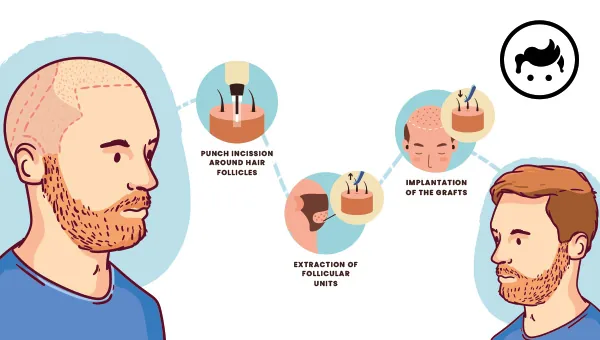
Recovery time following a hair transplant treatment changes based on the method used and the individual’s healing rate. A person often returns to work within a few days to a week subsequent to the surgery. The recipient feels redness, swelling, and crusting at the transplant site within the primary healing phase, which lasts from a few days to a week. The transplanted hair possibly does not begin to grow for many months, and the final effects possibly do not be evident for much longer. Noting that the healing period and outcomes vary from person to person, following the surgeon’s post-operative recommendations is essential for the best results.
The transferred hair is going to begin to fall out roughly 10 to 14 days subsequent to a hair transplant. It is a regular part of the curative process, and there is no need for alarm. The shedding happens as the freshly embedded hair follicles undergo a process known as “shock loss,” in which the hair momentarily falls out before regrowing. The process usually lasts a few weeks, during which the hair initiates to regenerate. The new hair growth is possibly extremely fine and difficult to see at first, but it will gradually thicken and become more evident as time progresses. Furthermore, assessing the body’s reaction is essential ten days after the transplant. Any indicators of refusal or problems are going to be continuously watched. They are given drugs to help them avoid rejection and manage any adverse effects. The client possibly is at the hospital or a rehabilitation center during recovery subsequent to the transplant. Their healthcare team, which involves the transplant surgeon, transplant coordinator, and transplant professional, is going to continue to follow them.
The image below shows what happens 10-14 days after a hair transplant.
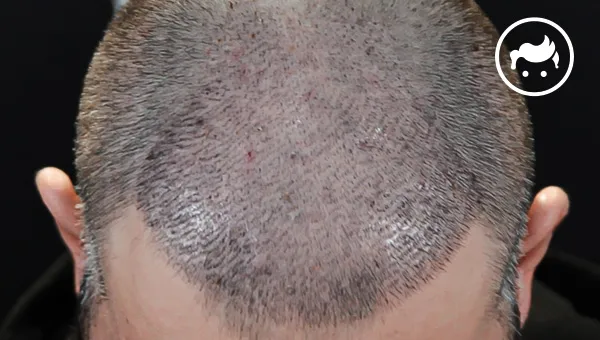
Some things to do after a hair transplant are to utilize the suggested ointments or lotions on the transplant site, keep the transplant site clean and dry, and keep the transplanted hair away from light, heat, and other things that are able to hurt them. Do’s and don’ts after hair transplant includes taking antibiotics to prevent infection, avoiding excessive physical activity, following a particular hair care routine to keep transplanted hair healthy, and seeing the surgeon to check healing and hair development. Moreover, it is critical to carefully adhere to the post-operative instructions and hair transplant aftercare provided by the surgeon after undergoing hair transplant surgery. Doing so is going to facilitate healthy wound healing and increase the likelihood of a positive result. On the other hand, there are Home Remedies of Hair Growth after Hair Transplant. First, blood circulation to the hair follicles improves with a bit of scalp massage, stimulating hair growth. Second, oil extracted from coconuts has been shown to promote hair development, hydrate, and strengthen the hair it already has. Third, studies on aloe vera’s influence on hair growth have proved promising. A combination of aloe vera gel and coconut oil has been shown to stimulate hair growth when applied to the scalp. Fourth, using onion juice on the scalp has increased blood flow, stimulating hair growth. Lastly, seeds from the fenugreek plant stimulate hair growth if they are soaked in water overnight and then ground into a paste before being applied to the scalp.
Yes, most hair transplant clinics provide hair transplant aftercare. Aftercare usually includes orders on how to clean the area, take care of the transferred hair, and avoid doing things that are able to hurt the transplanted hair. Clinics offer follow-up meetings to check how great the body is healing and how fast new hair is growing. Some clinics also offer extra services like scalp micropigmentation, laser therapy, PRP therapy, and medications to improve the outcomes of a hair transplant. These services turkey hair transplant cost extra, so it is best to talk to the clinic or surgeon to find out what they offer. It is essential to carefully follow the aftercare instructions given by the clinic or surgeon and to go to any follow-up appointments to improve the chances of a successful outcome.
Yes, eating fruits help hair transplant recovery fast. Fruits are a great addition to any healthy diet and aid in speeding up the healing process following a hair transplant. Fruits’ vitamin, mineral, and antioxidant content make them an excellent food choice for fostering robust hair development. Vitamin C, abundant in citrus foods such as oranges, lemons, and berries, stimulates collagen production, which is essential for hair growth. Vitamin A-rich fruits, such as apricots and cantaloupe, promote healthy scalps. Raisins give the iron necessary to prevent hair loss. Avocados and other biotin-rich fruits also strengthen hair, prevent hair loss, and promote strong growth. Moreover, remember that the outcomes of a hair transplant are possibly not fully apparent for up to a year following the procedure. Fruits for Hair Growth and Health are a significant element of a healthy diet and lifestyle that enhances health and well-being. Still, they are not a magic bullet that is going to ensure a quicker recovery or better outcomes. It is also crucial to adhere to the post-op guidelines supplied by the physician, who advises against eating specific fruits.
Yes, washing hair after a hair transplant is allowed. However, it is essential to adhere to the surgeon’s recommendations about when and how to wash hair. Typically, the patient is going to be instructed to wait a set number of days before shampooing the hair following surgery so that the transplanted hair follicles are able to begin recovering and the danger of infection is reduced. The hair transplant surgeon is going to give the patient specific instructions on when they are allowed to start washing their hair again. Waiting anywhere from two to five days following surgery to wash hair is standard. The patient must not expose the new hair to water or use treatments for the first few weeks after getting a hair transplant that potentially destroys the surgically implanted follicles. Moreover, it is essential to use a light shampoo and be careful when cleaning the transplanted region while washing the hair again. A period of abstinence from using hair styling products, such as gels and sprays, is also required. It is also vital to avoid activities that harm transplanted hair, such as exposure to chlorine or salt water or harsh chemical treatments, including dyeing or perming.
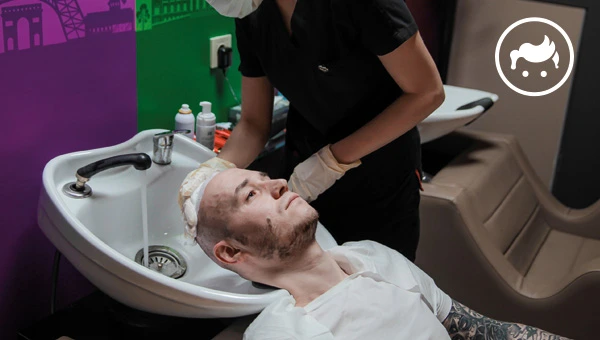
Yes, the sleeping position is also important after a hair transplant. It is essential to refrain from lying on the back or the side of the transplanted region for the first few days subsequent to the procedure. Doing so exerts pressure on the hair follicles that have been transferred, raising the likelihood that they are going to be damaged. The surgeon recommends sleeping in a just insignificantly reclined posture and using a few pillows to prop up the head and shoulders to avoid pressure on the transplanted region. It assists in protecting the newly transplanted hair from being touched or squashed, both of which have the potential to harm the hair follicles. A high cushion forces the head to slump forward, putting pressure on the transplanted area. It is vital to avoid sleeping on a pillow that is too high. Ask the surgeon about the dos and don’ts, including How to Sleep after Hair Transplant Surgery. It is critical to carefully adhere to the post-operative recommendations provided by the surgeon to facilitate correct healing and increase the likelihood of a positive result. Follow-up meetings with the surgeon must be scheduled to monitor the healing process and the development of new hair, as well as to enquire about any further instructions or suggestions that are necessary.
No, hair transplant failures do not happen often. Hair transplant failures are relatively uncommon, but they are able to happen. The outcome of a hair transplant process is affected by several variables, including the surgeon’s ability, the quality of the hair follicles being transplanted, and the patient’s general health. Choose a qualified and experienced surgeon with a solid track record who is able to set reasonable expectations for the operation. Additionally, adhere to all post-operative instructions carefully. However, bear in mind that hair transplantation is not a guarantee of success and that there is a possibility that the procedure’s result is unsuccessful.
Yes, having a hair transplant is helpful. A hair transplant is beneficial for those who are experiencing hair loss or their hair is becoming thinner. It is potentially a valuable method for restoring hair growth and improving the look of thinning or balding regions. Many individuals benefit from the surgery because it produces natural-looking results that boost self-confidence and enhance the overall quality of life. However, remember that hair transplants are not a one-time procedure and that numerous sessions are necessary to get the desired results. Set realistic goals and recognize that only some people are suitable for hair transplants. Moreover, visit a trained and experienced surgeon to explain the procedure’s advantages and hazards and assess whether a hair transplant is the best choice.
The doctor may suggest other treatments when a hair transplant fails. Additional hair transplant operations are one possibility. Sometimes several hair transplant operations are required to get the desired results. Additionally, talk to the surgeon about the possibility of taking hair-growing drugs like minoxidil or finasteride. Talk to the surgeon to find out the Reasons Why Hair Transplants Fails and to talk about how to fix the problem. Other options are scalp micropigmentation, laser therapy, and scalp reduction. Scalp micropigmentation is a cosmetic procedure that adds color to the scalp to make it look like there is more hair on the head. Laser therapy is a non-invasive treatment that is able to help speed up hair growth and make hair healthier overall. Scalp reduction is a surgical procedure that removes skin and pulls the hair-bearing scalp closer to make a bald spot smaller. Furthermore, look for another surgeon. Seek the services of another hair transplant specialist if dissatisfied with the outcomes or the treatments received. Hair transplantation is a process that takes a while to see the final results.
Extreme pain, persistent bleeding, evidence of infection, such as fever, redness, or swelling, or symptoms of an allergic response, such as rash or itching, must prompt a visit to the doctor in the days subsequent to a hair transplant. The physician is going to offer patients specific instructions for what to do after surgery, and they must follow them. Talk to the doctor about any worries or questions regarding the recuperation. Moreover, seek quick medical assistance if there are symptoms of an infected hair transplant follicle. Redness, swelling, warmth, pain, pus surrounding the afflicted region, and fever, chills, or general malaise are all possible symptoms of an infected hair transplant follicle. The doctor is going to take a sample of the afflicted region for lab analysis to confirm the diagnosis and establish the best course of therapy. Generally, antibiotics are used to treat an infected hair transplant follicle, while other procedures, such as cleaning and dressings, are also necessary. The surgeon decides to remove the afflicted grafts if the infection is severe or if it does not respond to antibiotic treatment. Adhere to the surgeon’s postoperative care recommendations and attend any planned follow-up visits.
